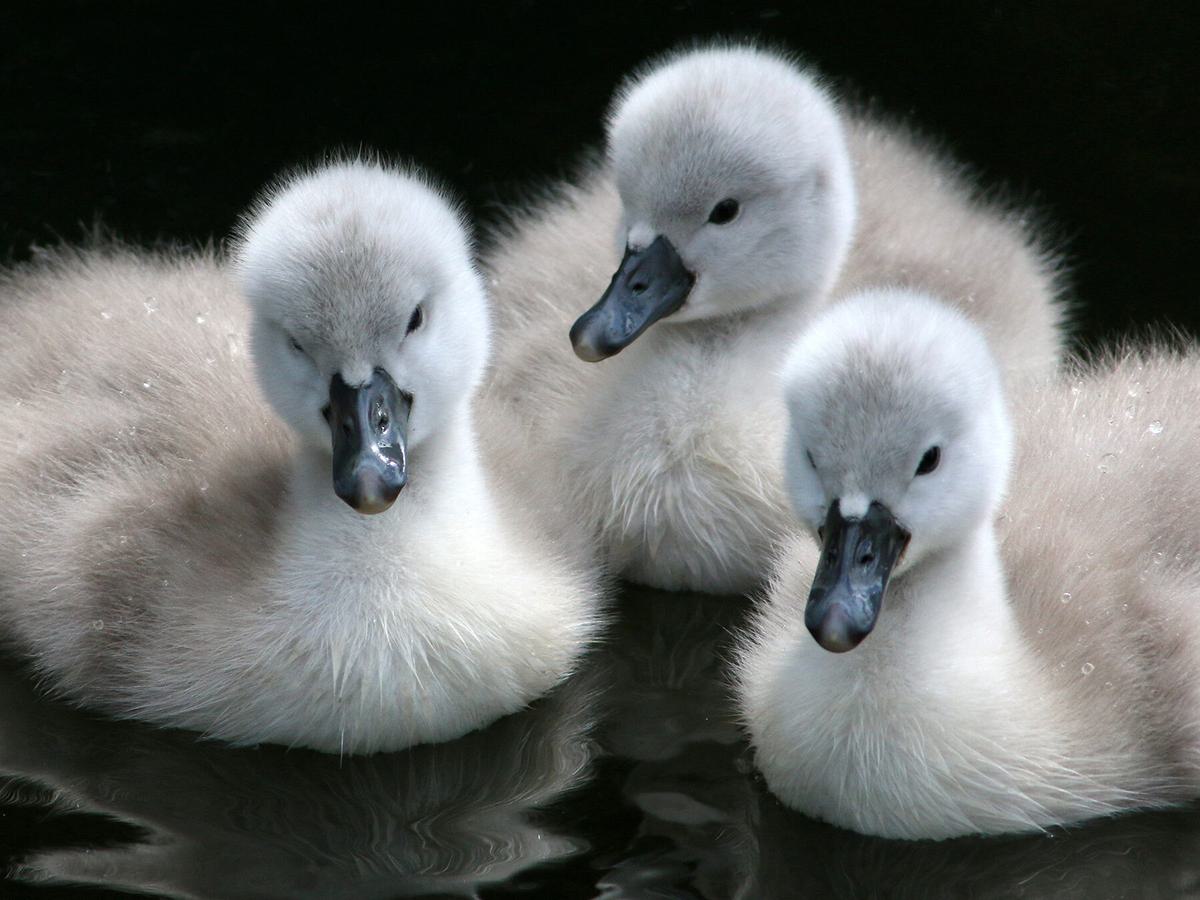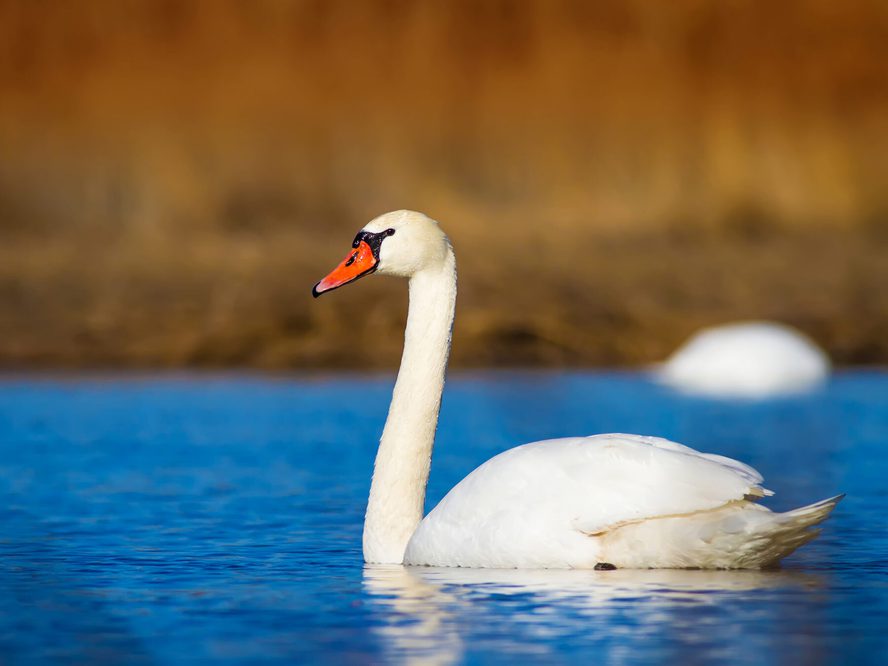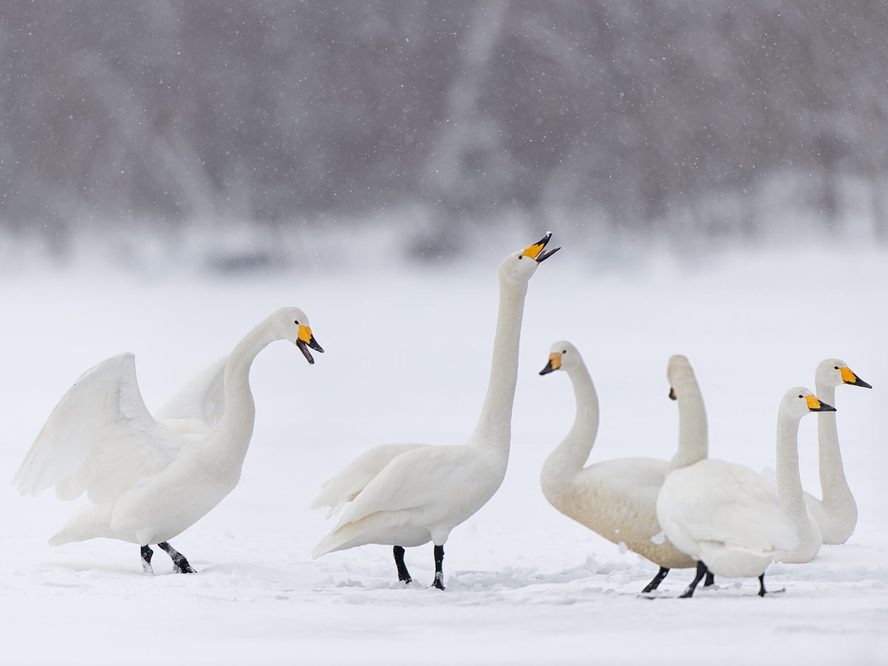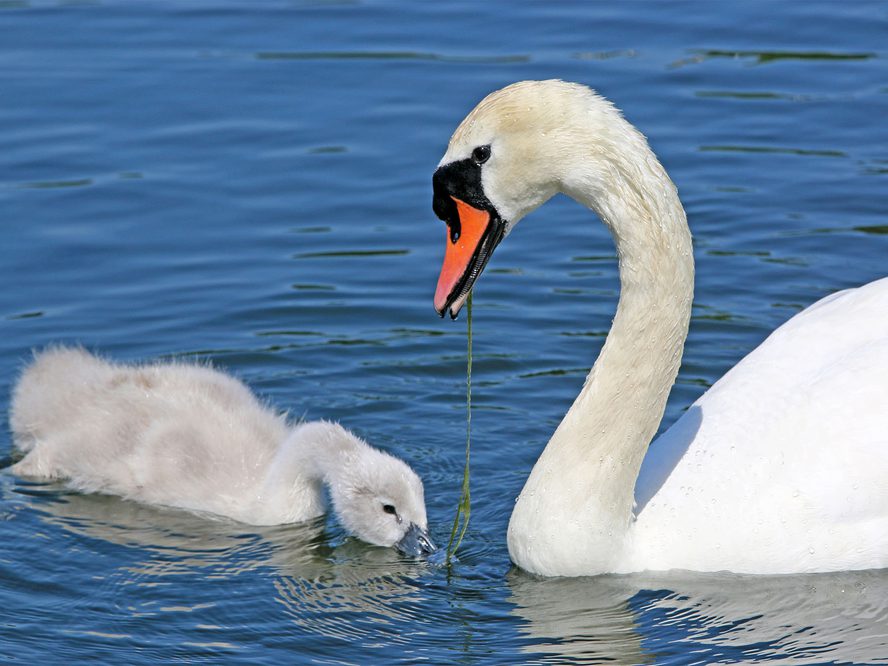Jump to Section
Baby Swans: All You Need To Know (With Pictures)
Last updated: 11 April 2022

Those familiar with the fairytale “The Ugly Duckling” by Hans Christian Andersen may remember how the ‘ugly duckling’ in the story was actually a baby swan and not a duckling at all! In real life, baby swans are not really ugly at all and are well-loved for their fluffy down.
This article will delve into baby swans, or cygnets, as well as their looks, behaviours and other characteristics. Of course, there will be many baby swan pictures along the way!
What does a baby swan look like?
Baby swans, or cygnets, hatch covered in a thick down. They're able to run and swim after just hours, but their parents remain very protective over them in the early months of their life.
Baby swans are typically dusky grey all over with a soft, fluffy coat and grey-black bill. They have small black feet. All cygnets have this appearance, and the babies of different species can be very hard to tell apart. Even the Australian Black swan has dusky grey cygnets that look similar to any other species.
Occasionally, cygnets hatch with all-white down and are known as 'Polish swans'. This seems to apply to Mute swans only.

Three young cygnets (baby swans) on the grass
How big is a baby swan?
Baby swans weigh around 250g (8.8 oz) and are approximately 20cm (8in) long. They’re the largest of the baby waterfowl, though they are similarly sized to geese chicks. After six months, they already reach around 6kg, reaching their maximum weight of about 14kg after around 3 to 4 years. Swans are very large and heavy birds - the Trumpeter swan is one of the heaviest flying birds in the world!
A side-by-side comparison of a cygnet next to a duckling shows how large they really are. Swan eggs are also very heavy at around 350 grams.
How much do baby swans weigh?
Baby swans weigh around 250g (8.8 oz) when newly hatched, which is quite hefty. For comparison, a Mallard duckling may weigh just 50 grams.
What do juvenile swans look like?
Juvenile swans remain primarily grey with some browny-grey patches that become increasingly lighter at around the 1-year mark. After one year, juvenile swans start becoming markedly white, though ‘dirty’ grey feathers will persist for another year at least.
A juvenile swan’s bill becomes pinkish before turning orange in the case of Mute swans at least (Trumpeters have black bills). Juvenile swans also typically lack the frontal knob of the bill. Juvenile swans are large birds in their own right, and whilst they mature over 3 to 4 years, they’re already approaching adult size after just two years.

Juvenile Mute Swan cygnets
What is a baby swan called?
Baby swans are called cygnets, which is derived from the Old French “cigne” meaning swan and originally from the Latin cygnus. The word cygnet for a baby swan is not to be confused with the word signet for a ring with letters carved into it.
What is a group of baby swans called?
There’s no specific name for a group of baby swans. Baby swans are found in flocks once they reach juvenile status after spending a year or so with their parents. Swan flocks contain a mixture of younger and adult birds, the juvenile swans typically forming their own small flocks in their sibling groups where possible.

A group of baby swans swimming together
What do baby swans eat?
Baby swans actually absorb a good deal of their egg’s yolk in their hatching process, which contains plenty of strongly concentrated macro and micronutrients. As a result, cygnets likely won’t feed for around a week after hatching. The quantity of yolk they absorb from the egg dramatically affects their chances of surviving this precarious early period.
After around a week, baby swans will instinctively feed themselves. They’ll sift through water in search of microscopic organisms and bite soft aquatic foliage like duckweed.

A family of swans eating weeds from the water
How do swans feed their chicks?
Swan parents have been observed indirectly feeding their checks. One method they use is to pull up aquatic vegetation and leave it to float on the surface of the water where a cygnet will eat it.
Another technique is by paddling vigorously to kick up various food-rich debris from the waterbed. This won’t continue indefinitely, and the chicks will forage for their own food too.
How many eggs do swans lay?
Swans lay around 6 to 10 eggs on average, though clutches as large as 14 have been recorded. The female will lay one egg every 1 to 2 days, typically starting no earlier than late March or early April (though this varies with the species of swan and location).
Swan clutches are quite large because survival rates are relatively low.

A swan in nest with eggs
What do swan eggs look like?
Swan eggs are around 10 to 12.6 cm long (4 to 5in) and 6 to 8 cm wide (2.4 to 3.2in). The eggs have a stony-white texture, and some may have a bluish tinge.

Seven eggs of a Mute Swan in the nest
How long do swan eggs take to hatch?
Swan eggs are incubated for around 35 to 41 days, after which they’ll begin to hatch over a 24 to 48 hour period.
When do swans lay eggs?
Swans lay eggs between late April and early June in the Northern Hemisphere. Black swans in Australia mate throughout much of the year but mainly between February and September.
How many baby swans survive in the months after hatching?
Around 50% of cygnets fail to survive longer than 2 to 3 months, and a further 25% are likely to die before adulthood. Swans that do survive go on to live long lives exceeding 20 years. Most cygnets die through predation, disease and parasites.
Cygnets born earlier in the season are more likely to survive, the odds for latecomers being much lower. Experienced swan couples will usually try and lay their eggs earlier in the season. Swans will learn from their mistakes and look to make amends in the next breeding season if they make mistakes that cost the survival of their brood.

Cygnets riding on the back of their parent
When can baby swans fly?
Cygnets generally take their first flight within 3 to 4 months of hatching. They’ll likely just swim briefly across the water - it’s naturally quite a safe landing in case anything goes wrong!
Baby swans have been observed following their parent’s cues, who line them up on a ‘runway’-like strip next to the water. This is a major milestone in the cygnet’s life and signifies a step towards leaving the family unit.
When do baby swans leave their nests?
Baby swans leave their nests after just days but stay very close to the parents for at least 4 to 5 months. Baby swans ride on the backs of their parents during this time, particularly when travelling through the territories of other swans. One of the primary threats to a baby swan is attacks by other adult swans - cygnets are very well guarded during the early days, and the parents are hyper-vigilant of their surroundings.
A defensive, territorial swan is a force to be reckoned with and whilst their ability ‘to break an arm with their wing’ is little more than an old wives tale, they’ve certainly been known to attack humans and other animals.

A Black Swan with their cygnet
Do swans reuse nests?
Swans do often return to their nest each nesting season, repairing and renovating it. This is true particularly when the swan parents have a successful and healthy brood of chicks in that nest. Swans are very intelligent birds with strong memory and recall skills, so they’ll remember safe nesting spots and try to return to them if possible.
How long do baby swans stay with their parents?
The soonest cygnets will leave their parents is after around four months, in the late autumn or winter of that same year. It’s more likely that they’ll stay with their parents until the following spring, which is around 8 to 12 months.
Baby swans and their parents are very attached for the first few months, but swan parents generally urge them to leave as soon as they’re ready, and when chicks are reluctant to do so, the parents may resort to fairly brutal tactics to drive them away. Of course, this is necessary to ensure the cygnet progresses to adulthood.

A family of Mute Swans with six cygnets
When do baby swans join flocks?
Baby swans stay with their parents for around one year at the most. Their parents will urge them to leave the family unit before then, if possible, especially if the swan can successfully fly by then.
When a juvenile swan leaves its parents, it’ll likely join a nearby flock, possibly with its parents, possibly without. If the swan joins with its parents, it’ll still become mostly independent from them. Swans winter in their communal flocks before the next breeding season, where they’ll split off into their breeding pairs once more.

Newborn Swan on the water
When do juvenile swans start breeding?
Juvenile swans likely won’t look for a mate until they’re two years old at the very youngest. Only the most precocious swans will breed at 2. Juvenile swans will look for a mate amongst their flock of swans at the start of the breeding season. Unmated pairs will watch and learn from the rather ornate and complex bonding displays of mated pairs.
Where do baby swans go at night?
Baby swans won’t leave the nest for around 2 to 3 days, in which time they’ll sleep in their mother’s soft down. Thereafter, swans nearly always sleep on the water, which is much safer than land for avoiding predators like foxes. Baby swans will sleep on the back or in the wing of a parent until they’re safe to sleep in the water on their own.
On this page
- What does a baby swan look like?
- How big is a baby swan?
- How much do baby swans weigh?
- What do juvenile swans look like?
- What is a baby swan called?
- What is a group of baby swans called?
- What do baby swans eat?
- How do swans feed their chicks?
- How many eggs do swans lay?
- What do swan eggs look like?
- How long do swan eggs take to hatch?
- When do swans lay eggs?
- How many baby swans survive in the months after hatching?
- When can baby swans fly?
- When do baby swans leave their nests?
- Do swans reuse nests?
- How long do baby swans stay with their parents?
- When do baby swans join flocks?
- When do juvenile swans start breeding?
- Where do baby swans go at night?








